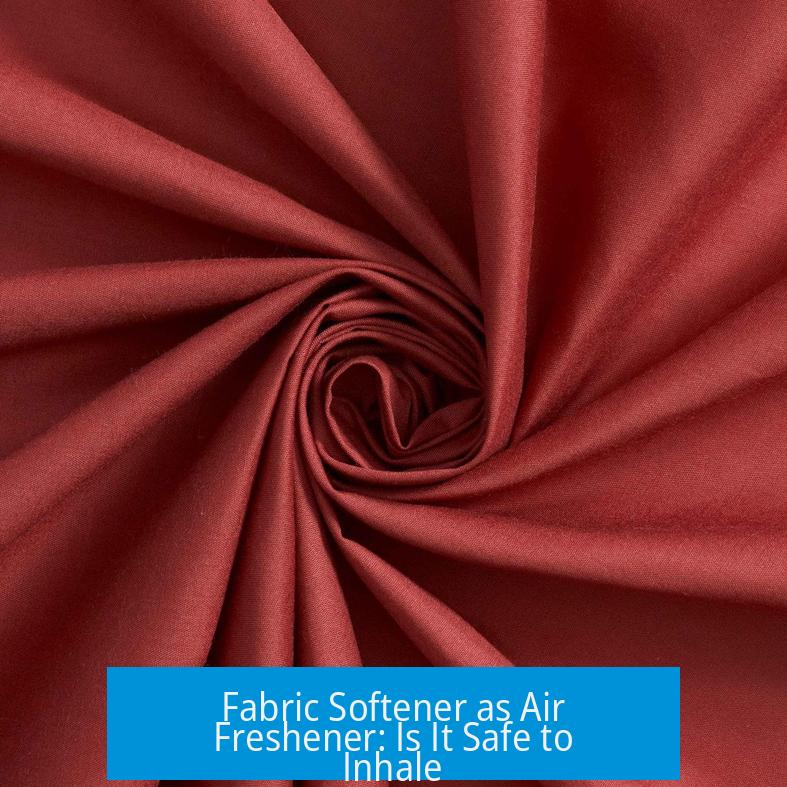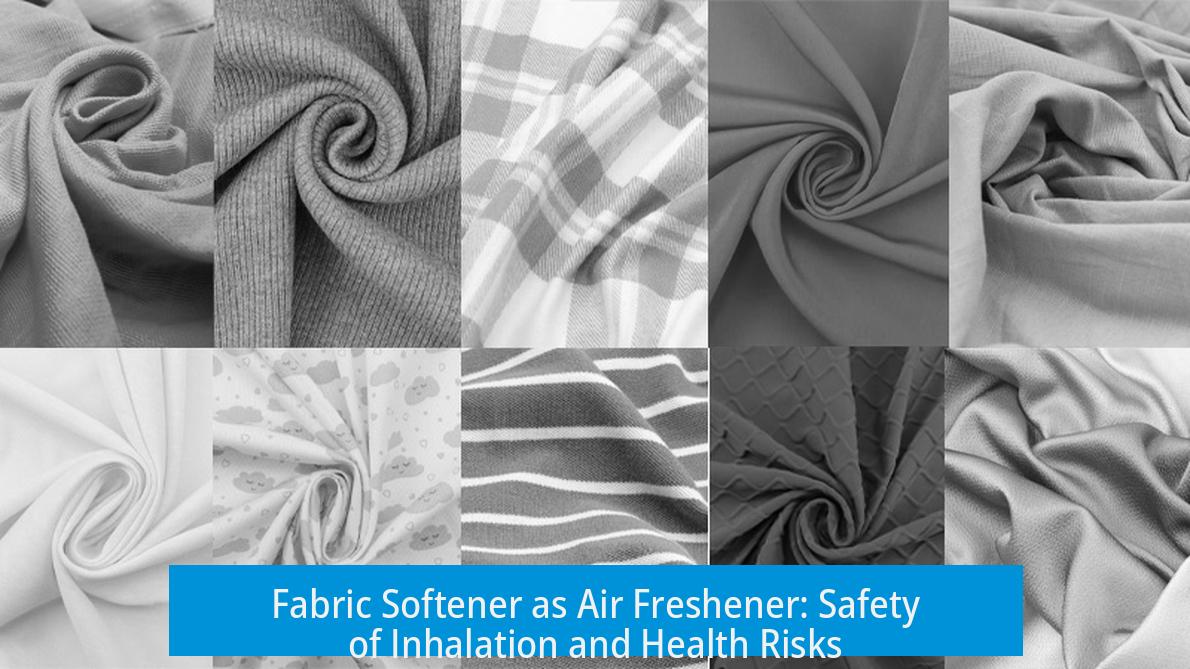Fabric Softener as Air Freshener: Is It Safe to Inhale?

Inhaling the scent of fabric softeners occasionally poses little risk, provided only the fragrance vapor is inhaled and not the liquid directly. However, using fabric softeners as air fresheners regularly or in enclosed spaces can expose individuals to chemicals not intended for inhalation, raising safety concerns.
1. Function and Intended Use of Fabric Softeners
Fabric softeners primarily serve to soften textiles and reduce static. They are not formulated for continuous air freshening purposes. The pleasant scent is a secondary benefit, not their main function. When used as designed, fabric softeners impart softness and fragrance to laundered clothes.
People may choose to use fabric softeners for their aroma rather than textile treatment, sometimes misting or placing dryer sheets in enclosed spaces, such as cars, to freshen the air.
2. Inhalation: Scent Versus Liquid
Inhaling the scent from fabric softeners, meaning breathing in the fragrance molecules dispersed in the air, generally carries minimal risk. This is comparable to smelling perfumes or scented products.
Conversely, inhaling the actual liquid form, such as concentrated fabric softener mist or vapor droplets, can be harmful. The liquid contains concentrated chemicals designed for fabric application, not human respiration.
3. Comparing Fabric Softeners and Commercial Air Fresheners
- Commercial air fresheners like those from the Involve Your Senses brand are formulated specifically for indoor air use. These products undergo safety and toxicity testing to minimize irritants or harmful emissions.
- By contrast, fabric softeners contain formulations intended for direct contact with fabrics, not for sustained airborne exposure.
- This fundamental difference means fabric softeners may release substances unsuitable for safe breathing when used as air fresheners.
4. Potential Safety Concerns from Inhalation
4.1 Chemical Exposure and Respiratory Impact
Fabric softeners contain compounds such as quaternary ammonium compounds, fragrances, preservatives, and surfactants. These chemicals may cause respiratory irritation if inhaled frequently or in high concentrations.
Repeated exposure can lead to headaches, nasal congestion, or even allergic reactions in sensitive individuals. Prolonged inhalation might contribute to respiratory discomfort or exacerbate pre-existing conditions, such as asthma.
4.2 Sensitivity to Fragrances
Strong fragrances can affect people differently. Some exhibit hypersensitivity to particular chemicals or scents, resulting in irritation or discomfort in confined environments such as vehicles.
Individuals with chemical sensitivities or allergies should avoid exposure to fabric softener aromas used as room or car fresheners.
4.3 Fire Hazard Consideration
Fabric softener sheets and liquids are flammable under certain conditions. Using them near heat sources or leaving fabric softener items in a hot car could increase fire risks, albeit low.
5. The Sensory Experience of Using Fabric Softeners as Air Fresheners
5.1 Odor Profile
The fragrance in fabric softeners typically leans toward floral, fresh, or mildly sweet notes. These scents can resemble commercial car perfumes or generic air fresheners.
However, the intensity tends to be stronger or artificially concentrated, which some may find overwhelming.
5.2 Touch and Residue
Fabric softener sheets can deposit slight oily residues on surfaces. In enclosed spaces such as car interiors, this can soil plastics or fabrics where placed.
5.3 Visual and Aesthetic Factors
Fabric softener products are not designed for display. Sheets or bottles may look out of place inside a car. They lack the discreet or stylish design of air fresheners optimized for vehicle interiors.
5.4 Sound and Taste
The use of fabric softener sprays may produce a spray sound, which could be a minor nuisance. While taste is unrelated, a strong fragrance might influence the perceived freshness of the air, sometimes negatively.
6. Chemical Composition and Health Effects
| Chemical Type | Common Purpose | Potential Effects |
|---|---|---|
| Quaternary ammonium compounds | Fabric softening and anti-static agents | Respiratory irritation, allergic response, potential toxicity on prolonged exposure |
| Fragrances | Scent masking and aroma provision | May cause headaches, sensitivities, and eye/nasal irritation |
| Preservatives and surfactants | Product stability and fabric treatment | Skin irritation, dermatitis, mucous membrane sensitivity |
As surfactants, these chemicals act on surfaces including fabric and skin. Mucous membranes, like those in lungs, may also absorb these agents, raising the likelihood of irritant effects.
7. Practical Considerations and Anecdotal Experiences
Some individuals place fabric softener sheets over air vents in cars to diffuse scent. Anecdotally, this practice has not indicated severe health issues. Still, such use is not researched extensively.
Professionals recommend using fragrances formulated for air freshening, as they use refined scents optimized for inhalation safety and longevity.
Fragrance suppliers offer blends that mimic popular fabric softener scents, allowing for safer, purpose-built air freshener options.
8. Choices for Safe Air Freshening
- Opt for commercial air fresheners designed for cars or enclosed spaces.
- Look for products that provide scent profiles similar to fabric softeners if that aroma is preferred.
- Avoid misting fabric softener liquid indoors or in confined areas.
- Use dryer sheets cautiously, avoiding direct prolonged inhalation.
- Ventilate spaces regularly when using any scented product.
9. Summary of Key Points
- Inhaling the scent vapor of fabric softeners occasionally is low risk.
- Direct inhalation of the liquid or frequent exposure to airborne fabric softener chemicals can be harmful.
- Chemicals in fabric softeners may irritate respiratory tracts and cause allergic reactions.
- Flammability is a minor risk factor if fabric softener products are improperly used near heat.
- Commercial air fresheners provide safer, tested alternatives for enclosed spaces.
- Sensitivity to strong fragrances varies; choose products accordingly.
- Surface residue from fabric softener sheets may be undesirable in environments like cars.
Is it safe to inhale the scent of fabric softeners used as air fresheners?
Inhaling the scent of fabric softeners in small amounts is generally safe. The risk arises if you inhale the actual liquid or expose yourself to large quantities of chemicals over time. Occasional mild scent exposure is unlikely to cause harm.
What health risks come from using fabric softeners as air fresheners regularly?
Regular exposure to fabric softener chemicals can irritate the respiratory system. Some people may experience headaches, allergic reactions, or worsened breathing issues. Chemicals like quats and preservatives can cause these effects if inhaled frequently.
How do fabric softeners compare to commercial air fresheners in terms of safety?
Commercial air fresheners are made and tested for safe indoor use. Fabric softeners contain chemicals intended for fabric, not air. Using fabric softeners as air fresheners may expose you to untested chemical combinations and potential safety risks.
Are there fire hazards when using fabric softeners as car air fresheners?
Yes, fabric softener sheets and liquids can be flammable. Using them near heat or leaving them in a hot car may pose a minor fire risk. Caution is advised when placing these products inside vehicles.
Can fabric softeners leave residues or cause discomfort beyond smell?
Fabric softener sheets can leave oily residues on surfaces like car vents or dashboards. The strong, sometimes artificial scent may also be overwhelming or cause discomfort for people sensitive to fragrances.





Leave a Comment